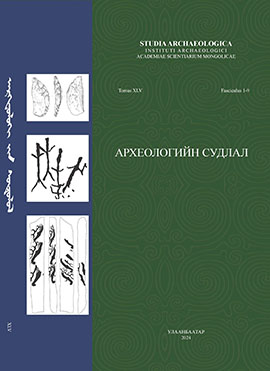Torus palatinus and torus mandibularis in skeletal remains from Xiongnu and Medieval period
DOI:
https://doi.org/10.5564/sa.v45i2.3785Keywords:
torus palatinus, torus mandibularis, Xiongnu, Medieval periodAbstract
Oral tori are bony growth present in the oral cavity and are not considered as pathological lesions. Smaller tori do not cause any problems, but larger sized tori can result in significant problems. The aim of this study was to determine the prevalence of torus palatinus (TP) and torus mandibularis (TM) in the two historical periods Xiongnu and Medieval period. A total of 90 skeletal remains were examined from both the Xiongnu (n=53; 25 male, 23 female, 5 child) and the Medieval periods (n=37; 13 male, 19 female, 5 child), which stored at the Human Bone Collection of the Institute of Archaeology, MAS. A total of 8 Xiongnu individuals (15%) and 5 Medieval period individuals (13.5%) presented with TM, while 5 Xiongnu (9.4%) and 2 Medieval period individuals (5.4%) had TP. In both historical periods, TP and TM were more common in the 20-39 age group and more frequent in males than females. The correlation between the torus palatinus and the torus mandibularis is statistically significant at 0.01 level. The results of the present study demonstrate that the prevalence of tori in the studied Xiongnu and Medieval populations is low. There is a tendency for the prevalence of tori to increase with age, although this is not a statistically significant trend.
Хүннү болон Дундад зууны үеийн хүний ясан дээрх эрүү ба тагнайн торус
Хураангуй: Амны хөндийн торус нь амны хөндийд ажиглагддаг ясны ургалт бөгөөд энэ нь өвчлөлд ордоггүй байна. Жижиг хэмжээтэй торус нь тухайн хүний амьдралын чанарт нөлөөлдөггүй ба харин томоохон хэмжээтэй торус нь хэл ярианы хөгжилд нөлөөлөх зэргээр өдөр тутмын амьдралд хүндрэл учруулах боломжтой. Энэхүү судалгааны зорилго нь Хүннүгийн болон Дундад зууны үе дэх тагнайн торус болон эрүүний торусын тархалтыг тодорхойлох явдал юм. Уг судалгаанд ШУА-ийн Археологийн хүрээлэнгийн хүний ясны сан хөмрөгт хадгалагдаж буй Хүннү (n=53; 25 эрэгтэй, 23 эмэгтэй, 5 хүүхэд) болон Дундад зууны үеийн (n=37; 13 эрэгтэй, 19 эмэгтэй, 5 хүүхэд) нийт 90 палеоантропологийн хэрэглэгдэхүүнийг хамрууллаа. Судалгааны үр дүнд Хүннүгийн 8 бодгаль (15%), Дундад зууны үеийн 5 бодгаль (13.5%) нь эрүүний торусын эмгэгтэй байсан бол Хүннүгийн 5 бодгаль (9.4%), дундад зууны үеийн 2 бодгаль (5.4%) нь тагнайн торустай байжээ. Судлагдсан түүхэн үеүдэд тагнайн торус болон эрүүний торус 20-39 насны бүлгийнхэнд түгээмэл тохиолдож байгаа бөгөөд хүйсийн хувьд эмэгтэйчүүдээс илүү эрчүүдийн дунд илүү ажиглагдаж байна. Тагнайн торус болон эрүүний торус хоорондын хамаарал статистикийн хувьд 0.01 түвшинд байна. Энэхүү судалгааны үр дүнд судлагдсан Хүннү болон Дундад зууны үеийн хүн амд торусын тархалт бага байгааг харуулж байна. Торусын тархалт нас ахих тусам нэмэгдэх хандлагатай байдаг ч энэ нь статистикийн хувьд ач холбогдолтой хандлага биш юм.
Түлхүүр үг. Тагнайн торус, эрүүний торус, Хүннү, Дундад зууны үе
Downloads
313
Downloads
Published
How to Cite
Issue
Section
License
Copyright (c) 2024 Misheelt Bayarsaikhan

This work is licensed under a Creative Commons Attribution-NonCommercial 4.0 International License.
Copyright on any research article in the Studia archeologica is retained by the author(s).
The authors grant the Studia archeologica license to publish the article and identify itself as the original publisher.
![]()
Articles in the Studia archeologica are Open Access articles published under a Creative Commons Attribution-NonCommercial 4.0 International License - CC BY NC.
This license permits use, distribution and reproduction in any medium, provided the original work is properly cited.




